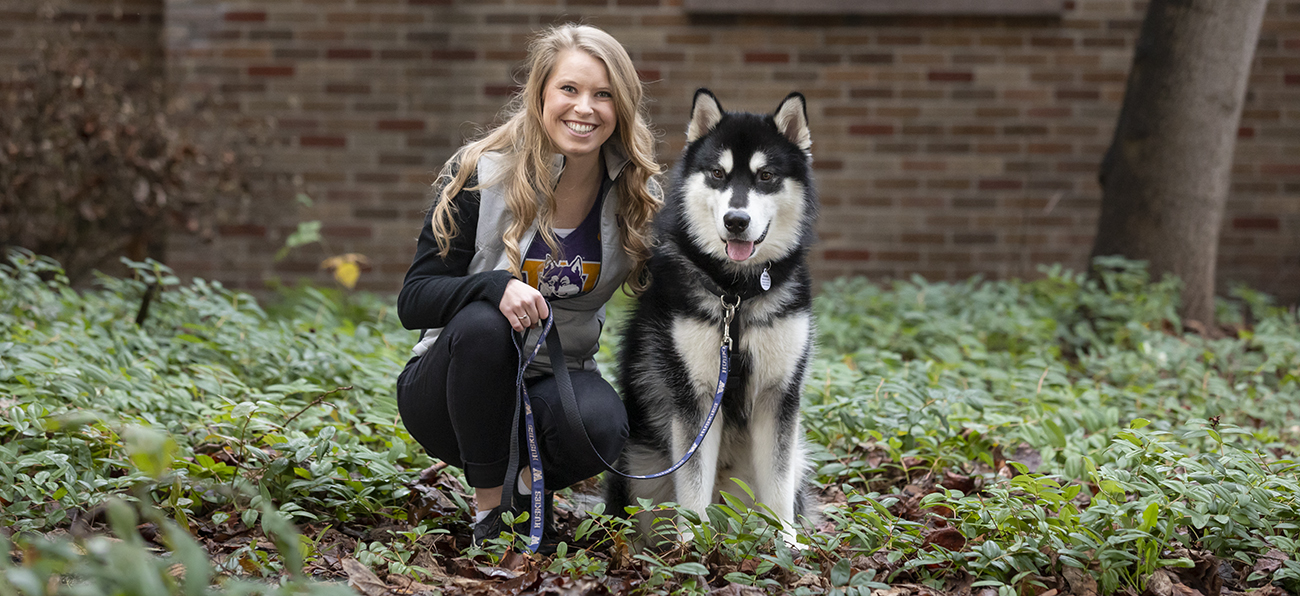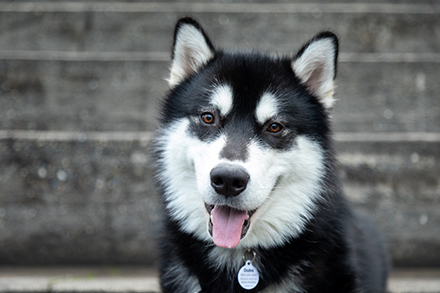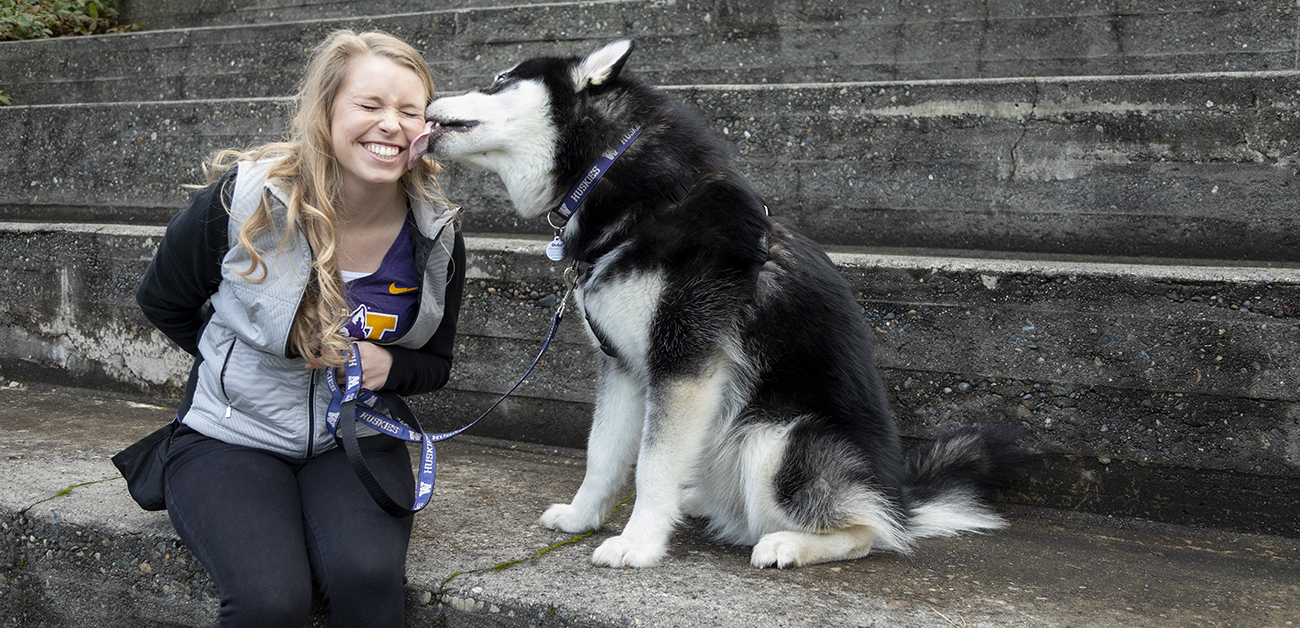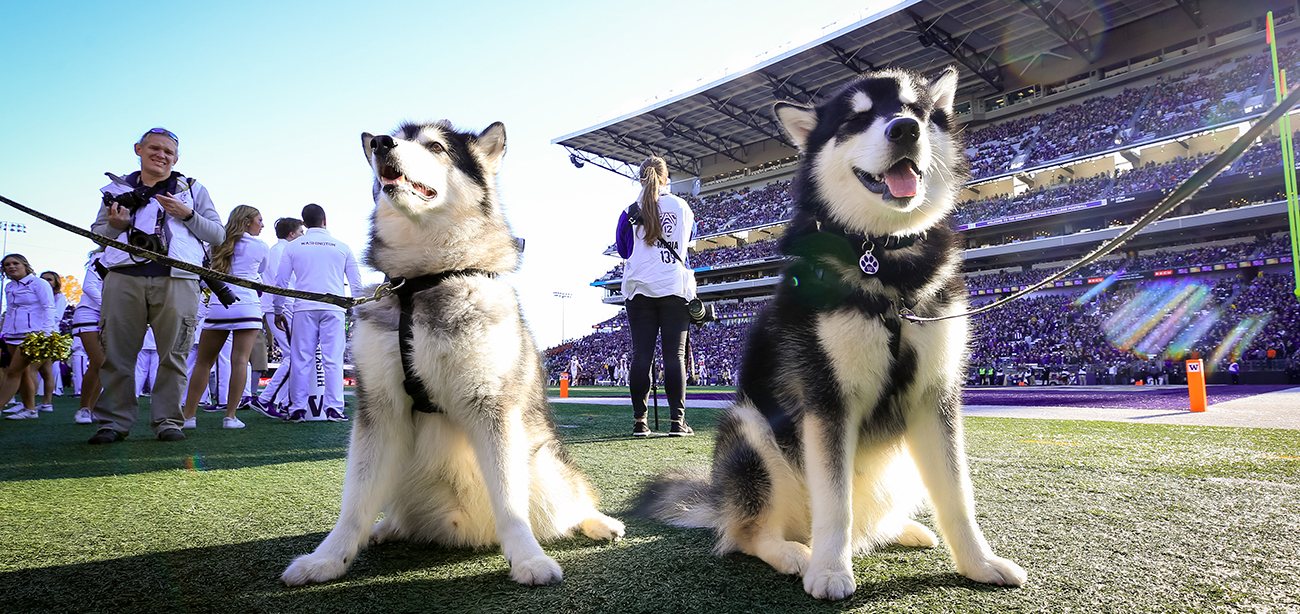
Anne-Lise Nilsen’s career has gone to the dogs. She wouldn’t have it any other way.
Nilsen (BS, Psychology, 2014) is the trainer for Dubs II, the successor to the UW’s newly retired canine mascot Dubs. As trainer, she chose the puppy who will be the new furry face of the Huskies and is preparing Dubs II for his very public role.
“Dubs paved the way for Dubs II,” Nilsen says. “When Dubs started, he did a handful of events throughout the year. He’s now at upwards of 40 events a year, and he leads the team out at football games. There’s so much he’s been able to do as the University’s mascot.”
Nilsen has nearly two decades of experience working with dogs, starting with her first bichon frisé puppy at age 7. She discovered a love for dog training through Dog 4H in Seattle. As a teen she competed in youth events with the American Kennel Club, once making it to the Bichon Frisé Nationals. Around the same time, she developed a dog training lesson plan to help pet owners in her bichon frisé play group.

As a student at Seattle’s Ballard High School, Nilsen completed a research project on social hierarchy in dogs. For advice on research methods, she reached out to animal behavior specialist James Ha, UW professor of psychology (now emeritus). “He was extremely welcoming,” Nilsen recalls of Ha, who continues to be a mentor. “He helped me with all the stats, and later got me to present my research at an Animal Behavior Society meeting.”
Through Ha, Nilsen learned that the UW Department of Psychology offers an emphasis in animal behavior. She loved the idea of a psychology degree, which she felt would inform her work with dog owners as well as their four-legged companions. For her psychology honors thesis, Nilsen once again worked with Ha, studying how different dog breeds relearn a task when some aspect of the task changes. She liked that the research, an exploration of animal cognition, had direct application to her dog-training work.
There are so many things I learned from Dubs that I’m now applying to Dubs II.
Dubs was among the 25 dogs in Nilsen’s honor thesis study. She had begun working with him sophomore year, as one of four or five student handlers overseeing Dubs’ event appearances. Student handlers serve as Dubs’ advocates at events and report any concerns, from unusual behavior to challenging conditions that might require further training. “There are always things that change,” says Nilsen. “Athletics may add fireworks during game day, or change the order of things Dubs is expected to do. All of that requires extra learning.”
Nilsen continued as a student handler until graduation, and later was hired to train the handlers in addition to her day job as manager of a doggy day care in Mukilteo, Washington. Given her history with Dubs, it’s no surprise that UW Athletics asked her to lead the search for, and training of, his canine successor.

Nilsen’s dogged (ahem) search led to a puppy from a local breeder, with classic markings and an even temperament. “Something would change in his environment and he wouldn’t spook,” Nilsen recalls. “He would just sit back and let whatever it was happen, and then investigate, which is exactly the type of temperament that can succeed in a stadium full of Husky fans.” Nilsen also helped choose Dubs II’s family, to ensure a happy home life when he is off the clock. (Yes, it’s a family of Husky alums.)
Despite being the Husky mascot, Dubs and Dubs II are not huskies. They are malamutes, a closely related breed that tends to be larger and more opinionated. “I like malamutes for this type of role because chaos is less likely to rattle a malamute than the Siberian husky,” Nilsen explains. “Being a Nordic breed, they are one of the breeds genetically closest to wolves, and because of that they tend to be independent thinkers. But if you set them up to succeed by giving them the right tools and rewards, they are typically very intelligent in addition to being good with people, including children.”

Following Dubs long reign as UW’s top dog, Dubs II has big paws to fill. To ensure his success, Nilsen began training him at eight weeks, slowly acclimating him to the massive stadium and camera flashes and overeager fans that will be part of his life. Once he is fully matured, he will attend 40 or more events a year, with Nilsen reviewing every event request to ensure his well-being.
Though Dubs II will not reach adulthood for another year, he was officially anointed as the UW’s new canine mascot in November, at a passing-of-the-collar ceremony in Husky Stadium during the last home game. “It’s one of those bittersweet things,” says Nilsen. “I didn’t want to see Dubs retire because that was my college experience. He was my first love when it comes to malamutes. But now having Dubs II as this all-encompassing project, it is so much fun to see all that he is becoming and all that he can do. There are so many things I learned from Dubs that I’m now applying to Dubs II.”
With Dubs II’s “red shirt season” complete, Nilsen will ramp up the training of his student handlers, who will eventually accompany Dubs II on his mascot duties without Nilsen present. But Nilsen will continue to prepare Dubs II for new challenges and opportunities as they arise.
“The University’s live mascot program has so much growth potential,” says Nilsen. “I hope to be a part of the program for years to come. It’s such a cool way to stay involved with the University.”
More Stories

The Public Impact of Private Cities
Geography major Edwin Bai has researched private cities, developed by individuals and corporations, that "take the libertarian idea of low government regulation to the maximum."

Demystifying Quantum
In a physics course for non-STEM majors, Professor Miguel Morales teaches quantum mechanics without the advanced mathematics most quantum courses require.

Can Machines Learn Morality?
UW researchers at the Institute for Learning & Brain Sciences and in the Allen School are exploring the potential for training AI to value altruism.